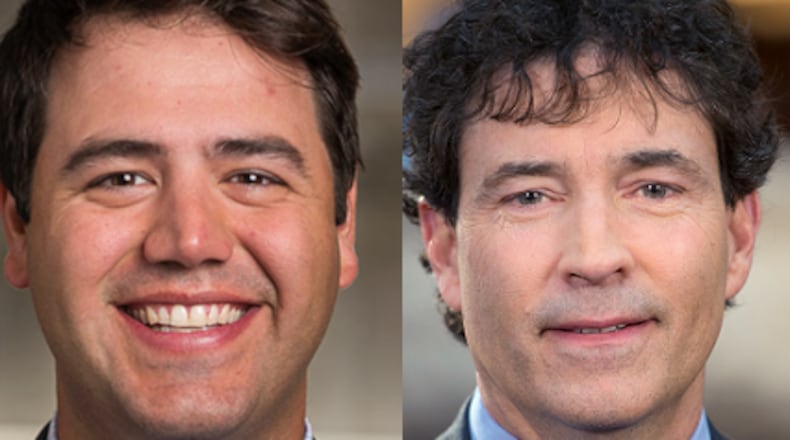But with growing signs the race is close, well-funded outside groups such as the Congressional Leadership Fund have stepped in. The fundraising behemoth headed by Republican consultant Corry Bliss reported having $71 million in campaign cash at the end of last month, including $30 million in donations from Adelson and his wife Miriam.
The Congressional Leadership Fund is among a half-a-dozen independent organizations spending hundreds of thousands of dollars each in a race that is seen by many as a test case of what might happen in November.
If the GOP can’t hold onto a reliably Republican seat in August, Republicans fear November could spell real trouble for the party. The high stakes led Vice President Mike Pence to visit the district this week to campaign for Balderson, and Gov. John Kasich taped a commercial in support of the state Senator.
The National Republican Congressional Committee (NRCC), headed by Rep. Steve Stivers of Upper Arlington, plans to spend $501,000 on TV advertising in a district that stretches from Mansfield through the northern Columbus suburbs and east to Zanesville. The election is Tuesday.
The Democratic Congressional Campaign Committee already is spending $238,000 on TV commercials, while Priorities USA Action and For Our Future — two liberal groups hoping to elect O’Connor — have joined with the House Majority PAC to spend $140,000 on digital commercials and get-out-the-vote efforts.
But all have been dwarfed by the Congressional Leadership Fund. In addition to the Adelsons, the group’s funders include Occidental Petroleum, The Scotts Company in Ohio, and Thomas Rastin of the Ariel Foundation in Mt. Vernon.Democratic groups have decried the outside money, saying it turns races into who has the most cash.
“The problem is, this is the corrupt system the Supreme Court has created,” said Fred Wertheimer, president of Democracy21, a public-interest organization in Washington. “It’s a terrible system.”
“The idea the Congressional Leadership Fund is an independent super-PAC is absurd. This is an arm of the House Republican leadership and, as such, is prohibited — in our view — from accepting unlimited contributions.”
State Rep. David Leland of Columbus, a former Ohio Democratic Party chairman, called it “democracy bought and paid for, on steroids. This is what happens when democracy gets held hostage to the highest bidder, and I don’t think this was envisioned by our founding fathers that the person with the most money would have the most democracy.”
The Congressional Leadership Fund is a “super-political-action committee,” a vehicle used by both political parties. A super-PAC can raise unlimited donations from wealthy donors, corporations and labor unions and finance hard-hitting TV commercials or major grass-roots efforts.
This month alone, the leadership fund has spent $21,000 on phone calls to voters, $84,000 for a field organization to personally contact voters, $3,000 for people to hang campaign literature on front doors, and hundreds of thousands of dollars on TV commercials.
“They have been spending more than the NRCC on these races,” said Kyle Kondik, managing editor of Sabato’s Crystal Ball at the University of Virginia. “They have a ton of money. I’m not going to say they have supplanted the NRCC, but they have become a shadow NRCC.”
Courtney Alexander, a spokeswoman for the leadership fund, said, “Our role as an outside group is to close the spending gap.”
“Troy Balderson was being outspent three-to-one on TV, and we had the opportunity to go in and close the gap on TV as well as run a field campaign in the district, which has included phone-banking and extensive door-to-door canvassing across the district,” she said.
Stivers, whose reputation is on the line, said, “We have a simple strategy: We have to turn Danny O’Connor into a Democrat. That’s not that difficult to do. And then get our voters out.”
Whether all this money makes much difference is less certain. The Congressional Leadership Fund spent $2 million in March’s special congressional election in western Pennsylvania, but Democrat Conor Lamb scored an upset victory in what was regarded as a safe Republican district.
Terry Casey, a Republican consultant in Columbus, said “Even with $1 million on TV, if you don’t have a relevant message of importance to the voters in the district, it tends to get ignored.”
Because this is a special election, likely with low voter turnout, getting out the vote will be key for both sides. Conservation Ohio, an environmental organization backing O’Connor, plans to knock on 2,500 doors in the coming days to urge voters to support the Democrat, who is the Franklin County recorder.
“That is one of the challenges of any special election,” said Daniel van Hoogstraten of For Ohio’s Future, whose founders include the AFL-CIO and the National Education Association. “The focus of our field program is to inform voters that there is a special election and there is a real choice here.”
About the Author
